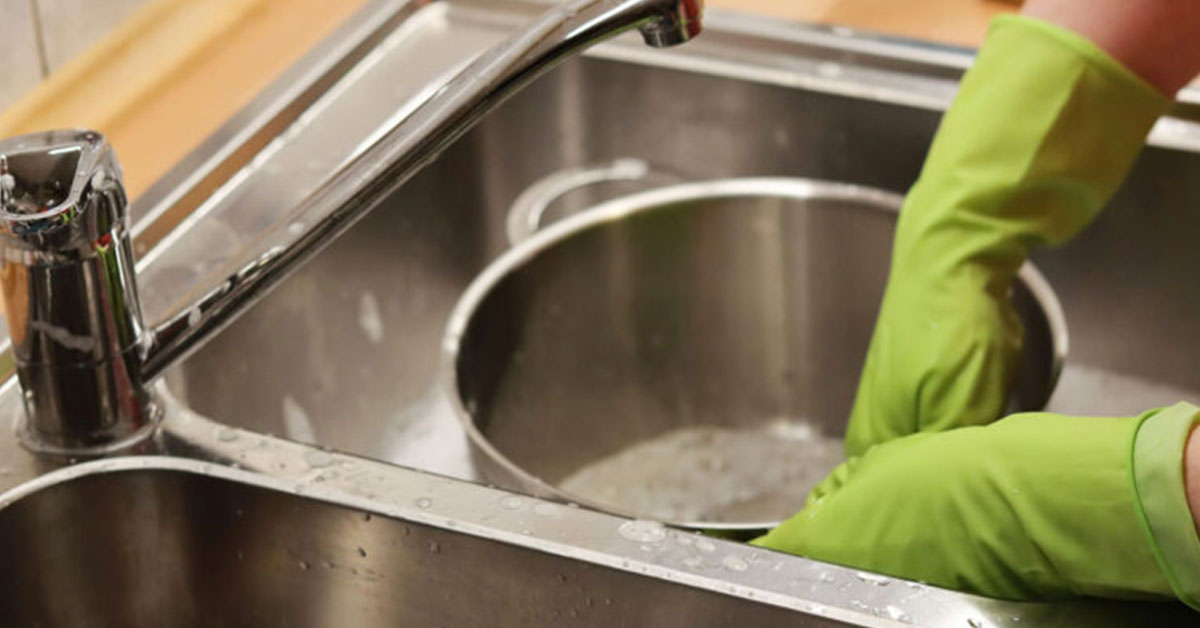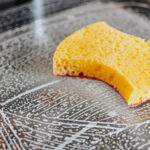
Never Buy Dish Soap Containing These 8 Toxic Ingredients
- Thomas Nelson
- August 9, 2022
- Sustainable Living
- 0 Comments
Dishes. We all have to do them sometimes. Whether it’s your favorite or least favorite chore, what you choose to wash your dishes with matters. Many brands of dish soap contain toxic ingredients that can harm your health as well as the health of the environment.
While dish soap has become an essential tool in our kitchens, aiding us in effortlessly removing grease and grime, it’s essential to be aware of what’s really in that soapy solution. Beyond the suds and pleasant fragrances, dish soap often contains a range of ingredients, some of which can be surprisingly toxic.
In this article, we did a deep dive into 8 of these ingredients and why you should avoid them. These are only recommendations based on our findings, you are encouraged to do your own research and settle on the brand you’re most comfortable with.
Fragrance
When you read a label and see the ingredient ‘fragrance,’ what exactly is that? There’s a saying among some that fragrance is the new second-hand smoke. Fragrance is a broad term for a mixture of up to 3,000 different chemicals, some of which can potentially be harmful. While specific fragrance formulations are typically proprietary and not fully disclosed on product labels, here are some common fragrance ingredients that have raised concerns:
- Phthalates: Phthalates are a group of chemicals used to enhance the scent in many fragranced products, including dish soap. Some studies have linked phthalate exposure to health issues, such as endocrine disruption, reproductive problems, and asthma.
- Synthetic Musks: Synthetic musks are often added to fragrances to provide a long-lasting scent. Some of these compounds, such as galaxolide and tonalide, have been detected in the environment and in human tissues. There are concerns about their persistence and potential for bioaccumulation.
- Aldehydes: Certain aldehydes, like benzaldehyde and formaldehyde, can contribute to fragrance in dish soap. Formaldehyde is a known human carcinogen and can cause skin and respiratory irritation.
- Volatile Organic Compounds (VOCs): Some fragrance ingredients release volatile organic compounds into the air, contributing to indoor air pollution. High levels of VOCs can irritate the respiratory system and worsen conditions like asthma.
- Allergens: Fragrance mixtures can contain allergenic compounds that may trigger allergic reactions in some individuals. Common allergens found in fragrances include limonene and linalool.
It’s essential to note that the specific formulation of fragrance in dish soap can vary between brands and products. Manufacturers are not required to disclose the exact ingredients in their fragrance blends, making it challenging for consumers to identify potential harmful components.
“Chemicals” can be a broad and ill-defined term, but in this instance, many of them are not good for human consumption. Over 1,200 of these chemicals have been identified as potential or known “chemicals of concern” according to a 2018 report from Women’s Voices from the Earth.
Triclosan
Triclosan (C12H7Cl3O2) is an antibacterial and antifungal agent commonly added to numerous consumer products, like toothpaste, detergents, dish soap, hand sanitizers, and even toys. Triclosan is a concerning ingredient due to its impacts on human health. Triclosan is known to have an impact on human development and reproduction, lowered testosterone and sperm levels, and may also affect the thyroid in children. Triclosan is noxious and should be avoided.
Triclosan goes by a few different names as well. Watch for Triclosan’s other names: Irgasan DP-300, Lexol 300, Ster-Zac, Cloxifenolum.
Sodium Lauryl Sulfate and Sodium Laureth Sulfate
Have you ever heard anyone say suds are a scam? You have now. The suds in your soap aren’t just soap’s expression of cleanliness, but the result of added chemicals. Sodium Lauryl Sulfate (SLS) and Sodium Laureth Sulfate (SLES) are both added to dish soap to increase foaminess and help with grease. These chemicals are known to remove natural oils from the skin, resulting in irritation and allergic reactions. They can also badly irritate the eyes and worsen skin conditions like eczema and dermatitis.
Other names for SLS include sodium monolauryl sulfate, sodium dodecyl sulfate, sodium monolauryl sulfate, sodium dodecane sulfate, lauryl alcohol, hydrogen sulfate – sodium salt, n-lauryl sulfate sodium, and sulfuric acid monolauryl ester sodium salt. SLES is sometimes called sodium alkylethersulfate.
Phosphates
In the context of household use, phosphates are generally used as a water-softening mineral. Phosphates are, unfortunately, harmful both to human and marine life. As you’re washing your dish soap down the drain, these phosphates get introduced to the natural environment and harm wildlife. When concentrations of phosphates become too high, they can lead to the growth of toxic algae and reductions in oxygen levels, essentially choking out aquatic wildlife. Phosphates have been recognized as a factor in chronic kidney disease and in the pathogenesis of bone and mineral disorders.
Common ingredient names for phosphates include phosphoric acid, pyrophosphates, polyphosphates, dicalcium phosphate and sodium phosphate.
Chlorine
Chlorine is a well-known chemical that most people have had significant exposure to. It’s generally pretty harmless for humans, at worst causing a minor burning sensation in the nose, throat, and eyes. The story is a bit different for wildlife. Chlorine is known to be toxic to fish, so as you rinse your dishes, that ingredient finds its way into the natural environment. Chlorine may also go by the name sodium dichloroisocyanurate.
Formaldehyde
Formaldehyde is commonly added to dish soap to enhance the soap’s chemical fragrances. In some instances, this chemical isn’t explicitly listed as an ingredient because it falls under ‘fragrance.’ Just because you don’t see it on the label doesn’t mean it’s not in there. You’ll want to look for brands that are certified formaldehyde-free.
Formaldehyde is known to cause rashes, shortness of breath, and changes in lung function at higher levels. It is a known carcinogen as well. Formaldehyde may go by the namesmethylene oxide, methanol, and methyl aldehyde.
Ammonia
In my research on ammonia, it’s clear that there is toxicity for both human life and the environment, but it’s difficult to assess exactly if the quantities present in dish soap present a danger. I opted to include this ingredient as one worth avoiding because of its potential to be harmful, especially if combined with chlorine.
Ammonia may also go by the names hydrogen nitride, Nitrosil, and Vaporole.
Diethanolamine, Monoethanolamine, and Triethanolamine
Diethanolamine, Monoethanolamine, and Triethanolamine, DEA, MEA, and TEA respectively, are known as amino alcohols and are commonly used in cosmetics, thickeners, wetting agents, detergents, and alkalizing agents. They are known to be hormone disruptors in the human body and can increase your risk of developing 1,4-dioxane contamination.
What should you use instead?
Finding a non-soap alternative to dish soap is a little rough. You can mix a bit of baking soda and water, creating a paste, and use that as an alternative. The disinfecting properties of baking soda likely fall short of soap. Another option is to peruse EWG’s list of 95 top scoring dish soap brands. These dishwashing cleaners all scored an A. You can view all of their ratings here.
There are also some effective and eco-friendly alternatives to potentially toxic dish soap that you can use to clean your dishes and reduce your exposure to harmful chemicals. Here are some options:
- Plant-Based Dish Soaps: Look for dish soaps labeled as “plant-based” or “natural.” These products often use biodegradable and non-toxic ingredients derived from plants. They can clean effectively without the harmful chemicals found in conventional dish soaps.
- Castile Soap: Castile soap is a gentle, vegetable-based soap that can be diluted and used as a dishwashing liquid. It’s free from synthetic additives and often comes in recyclable packaging.
- Baking Soda: Baking soda is an excellent abrasive cleaner that can help remove stuck-on food residues. It can be mixed with water to form a paste or used in combination with other natural ingredients.
- Vinegar: White vinegar is a natural degreaser and can be used to cut through grease and stains on dishes. It can be diluted with water and used as a rinse aid in your dishwasher as well.
- Lemon Juice: Lemon juice is naturally acidic and can help break down grease and grime on dishes. It also leaves a pleasant, fresh scent. Mix it with water or use it directly on tough stains.
- DIY Dish Soap: Consider making your own dish soap using simple ingredients like liquid castile soap, water, and essential oils for fragrance. There are many DIY recipes available online.
- Reusable Dishcloths or Brushes: Opt for reusable dishcloths or brushes made from natural materials like cotton, bamboo, or coconut fibers. These can be used with any of the above alternatives for effective dishwashing.
- Dishwasher Pods or Tablets: If you use a dishwasher, choose eco-friendly dishwasher pods or tablets that are free from harsh chemicals. These products are designed to clean your dishes effectively while minimizing environmental impact.
- Bar Soap: Some solid bar soaps can be used for dishwashing. Look for ones specifically formulated for this purpose.
- Composting for Food Scraps: To reduce the need for heavy dishwashing, consider composting food scraps before washing dishes. This can help minimize the amount of organic residue on your dishes.
Remember that the effectiveness of these alternatives may vary, so it’s a good idea to experiment and find the one that works best for your specific needs. Additionally, always check product labels and do your research to ensure that the alternatives you choose align with your environmental and health goals.
Keep Reading: No, You Don’t Actually Need Fabric Softener

